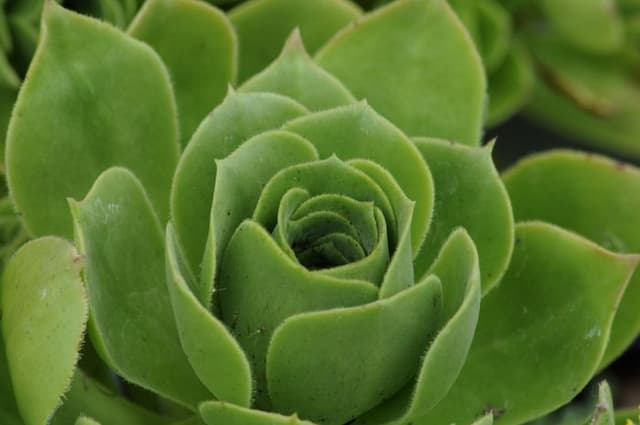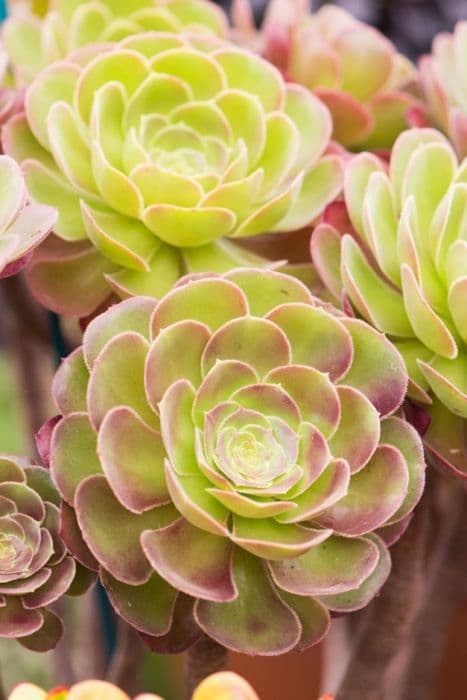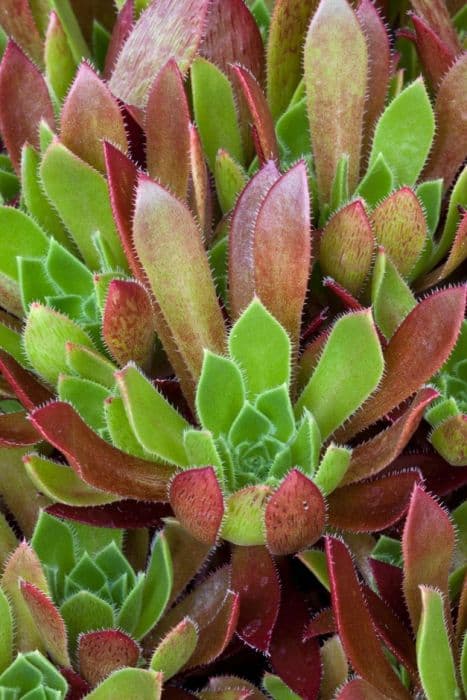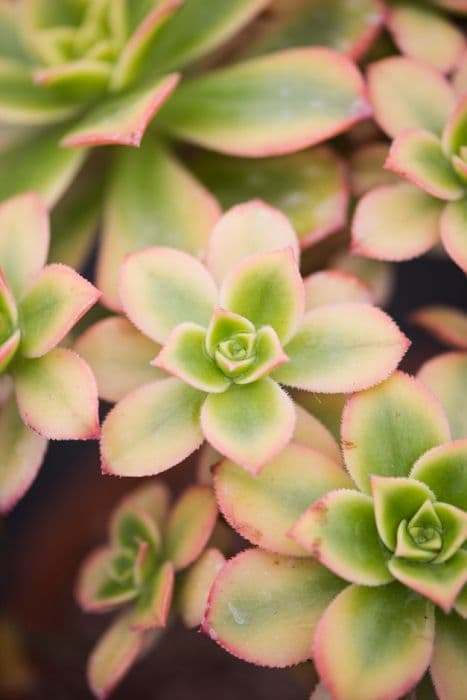Sempervivum 'Lilac Time'

ABOUT
Sempervivum 'Lilac Time', commonly known as houseleek, showcases a beautiful rosette form that is characteristic of the Sempervivum genus. The plant's succulent leaves radiate from the center, creating a symmetrical and compact appearance. These thick leaves are usually tipped with a unique lilac or purple hue, which emerges more prominently under certain conditions such as cooler temperatures or stress, hence the name 'Lilac Time'. The texture of the leaves is fleshy with a subtle, sometimes almost waxy, sheen. The color of the rosette ranges from deep green at the base to the softer, pastel lilac tones approaching the tips, giving it a two-tone effect. As the plant matures, the rosettes can produce offsets or "chicks", and these will cluster around the "hen" (the main rosette), spreading as a mat-like ground cover. The offsets are connected to the mother rosette by stolon-like structures. When this houseleek blooms, it sends up flower stalks topped with star-shaped flowers which can add to the visual charm of the plant. The overall look of Sempervivum 'Lilac Time' is one of hardy elegance and resilience, with its coloration and formation making it a popular choice for rock gardens, containers, and as an ornamental accent in xeriscaped areas.
About this plant
 Names
NamesFamily
Crassulaceae
Synonyms
Hen And Chicks, Houseleek
Common names
Sempervivum 'Lilac Time'
 Toxicity
ToxicityTo humans
Hen and chicks, the common name for Sempervivum 'Lilac Time', is generally considered non-toxic to humans. Ingesting any part of the plant is not expected to cause serious symptoms of poisoning.
To pets
Hen and chicks, the common name for Sempervivum 'Lilac Time', is not regarded as toxic to pets, such as cats and dogs. It is not known to cause serious harm or toxic reactions if pets ingest parts of this plant.
 Characteristics
CharacteristicsLife cycle
Perennials
Foliage type
Evergreen
Color of leaves
Green
Flower color
Pink
Height
6 inches (15 cm)
Spread
12 inches (30 cm)
Plant type
Succulent
Hardiness zones
3
Native area
Europe
Benefits
 General Benefits
General Benefits- Low Maintenance: Sempervivum 'Lilac Time', commonly known as Hen and Chicks, requires minimal care, making it a convenient choice for gardeners of all levels.
- Drought Tolerant: Once established, the plant has excellent drought resistance, needing only infrequent watering.
- Suitable for Xeriscaping: Its low water requirement makes it an ideal candidate for xeriscaped gardens designed to reduce irrigation.
- Cold Hardy: Hen and Chicks are resilient in cold climates, often capable of surviving freezing temperatures without protection.
- Attractive Foliage: The plant's rosettes provide year-round visual interest with their lilac-tinged leaves.
- Propagation: It easily propagates by offsets, allowing gardeners to expand their collection or share with others without buying new plants.
- Versatility: Hen and Chicks can thrive in a variety of settings, from rock gardens to container gardens, and even on green roofs.
- Garden Erosion Control: The plant's dense mat-forming habit can help prevent soil erosion on slopes and banks.
- Seasonal Interest: Sempervivum 'Lilac Time' blooms in summer, providing additional interest with its characteristic flower spikes.
- Pest Resistant: Generally resistant to pests and diseases, reducing the need for chemical treatments.
- Edible Qualities: Although not widely known for culinary uses, parts of the plant are edible and can be used in salads or as garnish.
- Attracts Pollinators: The flowers attract beneficial pollinators like bees to the garden, supporting local ecosystems.
 Medical Properties
Medical PropertiesThis plant is not used for medical purposes.
 Air-purifying Qualities
Air-purifying QualitiesThis plant is not specifically known for air purifying qualities.
 Other Uses
Other Uses- Sempervivum 'Lilac Time' can be used as a living roof covering to provide insulation and reduce rainwater runoff.
- These hardy plants can be grown in outdoor fairy gardens, providing a low-maintenance, drought-resistant option that adds texture and color.
- Artists and crafters sometimes use the rosettes in botanical art, pressing them to create natural patterns on paper or textiles.
- They can serve as a natural firebreak when grown extensively in wildfire-prone areas due to their high moisture content.
- The plant can be used in living walls or vertical gardens to add greenery to urban spaces without requiring much soil or maintenance.
- Children might use the plant's rosettes as 'forests' or 'trees' in miniature landscapes or dioramas for educational or playful activities.
- Due to their ability to absorb heat, these plants can be planted on green terraces to help regulate building temperatures.
- The rosettes can be incorporated into green table arrangements or wedding bouquets for an eco-friendly and unique touch.
- In large public gardens or parks, Sempervivum 'Lilac Time' can be used to spell out words or create designs when viewed from above.
- For culinary experimentation, certain Sempervivum species may be edible and used as a garnish, though this should be approached with caution and proper identification as some may not be suitable for consumption.
Interesting Facts
 Feng Shui
Feng ShuiThe Hens and Chicks plant is not used in Feng Shui practice.
 Zodiac Sign Compitability
Zodiac Sign CompitabilityThe Hens and Chicks plant is not used in astrology practice.
 Plant Symbolism
Plant Symbolism- Longevity: As its common name 'Hens and Chicks' suggests, Sempervivum propagates through offsets, creating new generations from the mother plant, symbolizing longevity and the enduring nature of life.
- Protection: The name 'Sempervivum' means 'always alive' in Latin, signifying resilience and protection. These plants are hardy and survive harsh conditions, often planted on rooftops to protect against lightning and fire in folk traditions.
- Perseverance: Due to its capability to endure and thrive in poor soil and drought conditions, Hens and Chicks symbolize perseverance and the ability to thrive in challenging environments.
- Renewal: The rosettes of Sempervivum 'Lilac Time' and their reproduction method reflect the theme of renewal and the continuous cycle of life, as the mother plant is replaced by its chicks.
 Water
WaterHen and chicks should be watered infrequently, as they are drought-tolerant succulents. You can water the plant deeply every 2-3 weeks, allowing the soil to dry out completely between waterings. Typically, applying approximately 1 gallon of water per plant will suffice for each watering session. During the winter, water even less frequently, possibly once a month, due to their dormant state. It's important to avoid water logging as this can cause root rot, so ensure excellent drainage in the pot or garden bed where the hen and chicks are planted.
 Light
LightHen and chicks thrive in areas where they can receive full sunlight for most of the day. They are well-suited for a sunny window sill, rock garden, or any other spot that receives at least 6 hours of direct sunlight daily. While they can tolerate some light shade, too little light can make them leggy and affect their compact rosette shape. To maintain their vibrant colors and health, ensure they get plenty of bright light.
 Temperature
TemperatureHen and chicks prefer temperate conditions and are hardy in temperatures ranging from about freezing (32°F) to around 80°F. They can survive in temperatures as low as -20°F with adequate protection or snow cover and can tolerate high temperatures as long as they are not exposed to excessive humidity. The ideal growing temperatures for hen and chicks typically range between 65°F and 75°F during the growing season.
 Pruning
PruningHen and chicks do not require regular pruning, but you may remove any dead or damaged leaves or offsets to maintain their appearance. Pruning is best done in the spring or early summer, when the plant starts its active growth period. If you are removing offsets, do so gently to not harm the mother plant or the offsets that you may want to replant.
 Cleaning
CleaningAs needed
 Soil
SoilThe best soil mix for Hen and Chicks (Sempervivum 'Lilac Time') is one that is well-draining, such as a cactus or succulent mix with added perlite or coarse sand for improved drainage. The ideal soil pH should be slightly acidic to neutral, ranging from 5.6 to 7.5.
 Repotting
RepottingHen and Chicks should be repotted every 2-3 years, or when you notice that it has outgrown its container, to ensure healthy growth and prevent root crowding.
 Humidity & Misting
Humidity & MistingHen and Chicks thrive in average to low humidity conditions. They prefer dry air and do not require high humidity levels, making them well-suited for typical indoor environments.
 Suitable locations
Suitable locationsIndoor
Place in bright light, allow soil to dry between waterings.
Outdoor
Full sun to part shade, well-drained soil, hardy.
Hardiness zone
3-9 USDA
 Life cycle
Life cycleThe life of a Sempervivum 'Lilac Time', also known as Hen and Chicks, begins with seed germination, where conditions such as light, temperature, and moisture trigger the development of the young plant. Upon sprouting, the seedling grows into a rosette-forming succulent, characterized by thick, fleshy leaves adapted to store water. As the plant matures, it produces offsets, or "chicks", which grow around the base of the "hen" or mother plant. These offsets can be separated and planted to propagate new plants. The Hen and Chicks live for several years before the mother plant flowers once, usually in the summer, producing star-shaped blooms, often in shades of pink or red. After flowering, the mother plant typically dies, leaving behind the offsets to continue the growth cycle.
 Propogation
PropogationPropogation time
Spring-Early Summer
Sempervivum 'Lilac Time', also known as Hen and Chicks, is most commonly propagated through offsets. These are the small, rosette-shaped mini-plants that form at the base of the parent plant. In spring through fall, these offsets can be gently pulled away from the main plant, ensuring that some roots remain attached. They should then be allowed to dry for a day or so to allow the cut ends to callous, reducing the risk of rot when planted. These offsets can then be placed on top of well-draining soil and lightly pressed in place. Watering should be minimal until the offsets have established their own roots, at which point they can be cared for similar to the parent plant. This method is simple and efficient, allowing gardeners to propagate many new plants from a single mature Hen and Chicks specimen.









